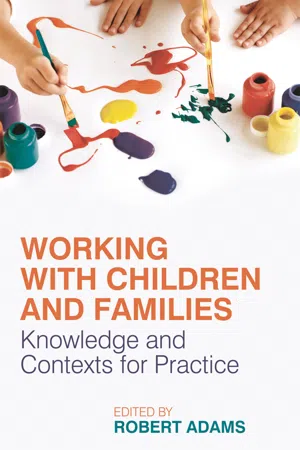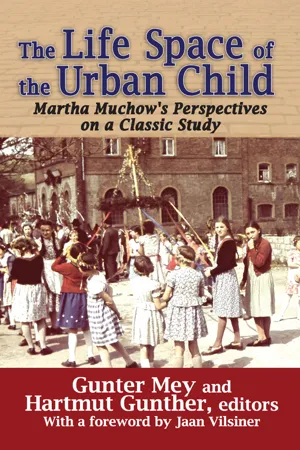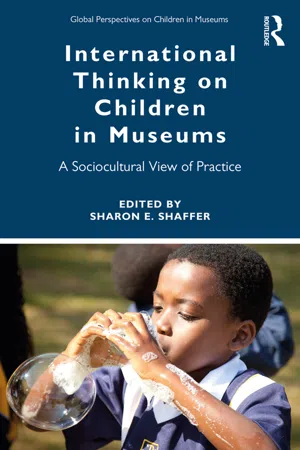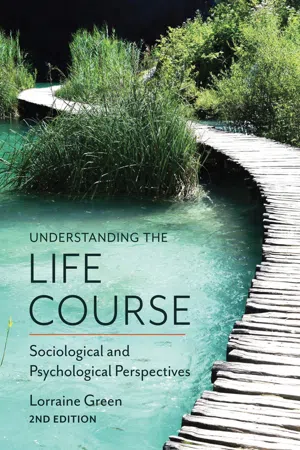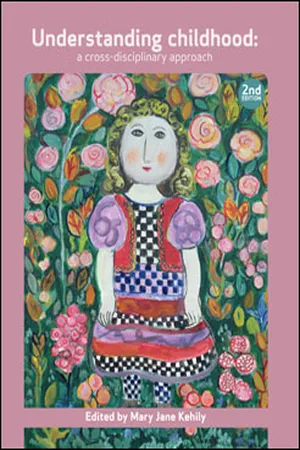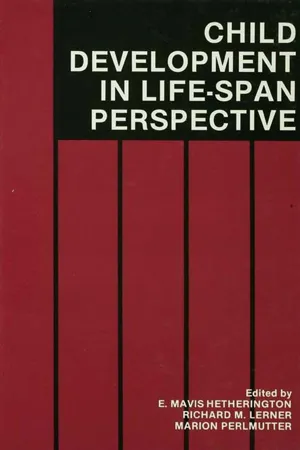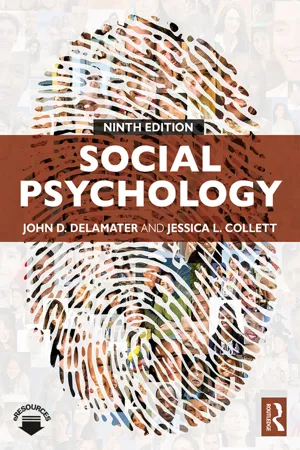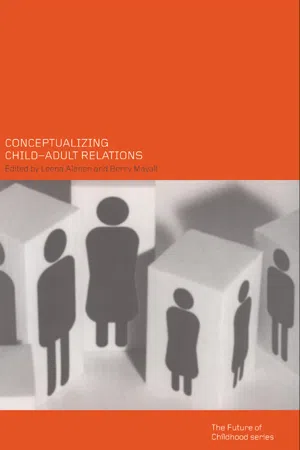Social Sciences
Sociological Perspectives of Childhood
Sociological perspectives of childhood refer to the various ways in which society views and constructs the concept of childhood. These perspectives can include examining how childhood is socially constructed, the impact of social institutions on children, and the role of culture in shaping childhood experiences. Sociological perspectives of childhood help to understand how societal factors influence the lives of children.
Written by Perlego with AI-assistance
Related key terms
10 Key excerpts on "Sociological Perspectives of Childhood"
- eBook - ePub
Working with Children and Families
Knowledge and Contexts for Practice
- Robert Adams(Author)
- 2011(Publication Date)
- Bloomsbury Academic(Publisher)
2 Social and Psychological Perspectives on Childhood and Child DevelopmentPassage contains an image
Michael WynessThe Social Construction of ChildhoodSociological Approaches to the Study of Children and Childhood 3 LEARNING OUTCOMES By the end of this chapter, you should be able to:understand the contested character of childhoodappreciate how childhood is a socially constructed and changing conceptdiscuss how this perspective on childhood affects approaches to research and practiceIn recent years, childhood has become a far more contested phenomenon, with public commentary shifting between the reporting of its terminal decline through to the promotion of a new pluralized and culturally embedded version of the child. Arguably, it is clear now that policy makers and professionals have embraced the latter view, working alongside children and their families in providing them with the support needed to take more control of their lives (Mayall, 2002). In this chapter, the sociological basis of this approach, the social construction of childhood, is outlined. First, I discuss the importance of the cultural and social dimensions of childhood and go on to explore the implications this has for understanding children’s lives. I then discuss the social construction of childhood in terms of the different ways that we might view children’s lives. Here we can start to talk about the diversity of childhoods. Finally, I explain why an emphasis on the cultural and social realms can lead to insights on children’s identities as relatively independent, rights-bearing members of society. In the final section, by way of a critique of social constructionism, I briefly explore alternative ways of researching children and childhood.Culture rather than biology
The work of Aries (1961) provides the early impetus for social constructionism, in that he challenges the orthodox view that childhood was a universal and ever-present feature of all societies. His often referenced argument is that childhood simply did not exist until around the 16th century. Beyond their physiological immaturity, children in the medieval period were rarely treated differently from adults. There was next to no awareness that children had to be nurtured and guided through a period called ‘childhood’ by responsible adults in order for them to become full members of their communities. While his thesis has been subject to numerous critical reviews, his work clearly establishes a distinction between ‘biological immaturity’ and the ways that this has been understood within specific societies and historical periods (Archard, 2004; Gittins, 1998). Childhood in modern Western societies is viewed as a set of powerful sentiments and ideas that have fundamental consequences for the way we view, treat and relate to children. - 2 Sociological Approaches to ChildhoodDOI: 10.4324/9780203023488-2There are significant ways in which the positions taken by sociologists and developmental psychologists on the issue of child development diverge, as we saw in the last chapter. Sociologists problematize the very idea of the child rather than treat it as a practical and pre-stated being with a relatively determined trajectory and certainly do not seek to offer advice concerning its appropriate mode of maturation. As I shall attempt here, sociology endeavours to realize the child as constituted socially, as a status of person which is comprised through a series of, often heterogeneous, images, representations, codes and constructs. This is an increasingly popular perspective within contemporary childhood studies (Jenks 1982b , 1989;Stainton-Rogers et al. 1989; Qvortrup 1993 ; James and Prout 1990) .Sociology is burgeoning in its innovative work in relation to children and in finding its way towards a concerted sociology of childhood and it still has a degree of exciting work to do. A major contribution consolidating such research was provided by James and Prout (1990) in a work that attempted to establish a new paradigm in our thinking. It is worthy of consideration here and I shall quote it in full; it can act as a manifesto in our subsequent considerations of the significance and relevance of sociological theory in our approaches to childhood:The key features of the paradigm:
- Childhood is understood as a social construction. As such it provides an interpretive frame for contextualizing the early years of human life. Childhood, as distinct from biological immaturity, is neither a natural nor a universal feature of human groups but appears as a specific structural and cultural component of many societies.
- Childhood is a variable of social analysis. It can never be entirely divorced from other variables such as class, gender or ethnicity. Comparative and cross-cultural analysis reveals a variety of childhoods rather than a single or universal phenomenon.
- eBook - ePub
The Life Space of the Urban Child
Perspectives on Martha Muchow's Classic Study
- Gunter Mey(Author)
- 2017(Publication Date)
- Routledge(Publisher)
By shifting the focus from the developmental to the social status of children, sociologists of childhood also abandoned the idea of the child as “the other,” as ontologically different (from adults). Children were no longer seen as only natural, biologically driven creatures, and childhood was not regarded as an immutable state of nature. Instead, childhood now was understood as a social phenomenon (Qvortrup 1994) or a social construction. As such, it could be understood as a historical and cultural framework, which constitutes its members’ lives in a specific way. Childhood as a particular socially defined “time space” has a structuring function that enables or refuses social participation for its members, the children. Different implementations of childhood are seen as products of historical and cultural constructional processes. With this in mind, sociological efforts concentrated on researching and questioning followed by deconstructing the ideas of childhood and placing them into their social relativity. The real-life conditions of children in their childhoods were studied within their societal constitution(s) and configuration(s), allowing the children’s own interpretations as well as their cultural efforts and performances to come into focus.The sociology of childhood worked at the micro as well as at the macro level to recognize an understanding of childhood and children’s lives. More subject- or actor-orientated theoretical approaches (e.g., Hellett and Prout 2003) complemented context- and structure-orientated approaches (e.g., Goldson, Lavalette, and McKechnie 2002; Wintersberger et al. 2007; Wyness 2011). Although these two approaches differ analytically and systematically, it is important that they complement rather than exclude each other and have always been developed by the sociologists of childhood, respectively taking reference to each other. The subject-orientated approach picked up the idea of children as social actors theoretically, later framed in the concept of childhood agency. In the context-orientated approach relating to social structure, childhood is understood as a social construction, which is always reproduced anew in everyday and institutionalized practices. The theoretical concept of generational order emerged from the idea of childhood as a structuring social category (James, Jenks, and Prout 1998), and points to the asymmetrical power hierarchy of the social categories of childhood and adulthood. - eBook - ePub
International Thinking on Children in Museums
A Sociocultural View of Practice
- Sharon Shaffer, Sharon E. Shaffer(Authors)
- 2020(Publication Date)
- Routledge(Publisher)
Constructing and Reconstructing Childhood, the idea was to foreground children, a concept later to be labeled as “the conceptual autonomy of childhood” (p. x):Rather than seeing children as an aspect of something else (the family, the school, social work and social policy, the market, etc.), it [Constructing and Reconstructing Childhood] advocated placing children’s role, experiences and activities central to the pursuit of childhood studies.(James and Prout 2015, p. x)This newly developing view of childhood emerged in the 1990s with scholars thinking about children and childhood in a new light, moving toward a new “sociology of childhood … as a distinct sub-discipline” (James and Prout 2015, p. xi), an area of study that today is represented by research, conferences, journals, and university courses examining the topic. This change in the perception of childhood is noteworthy and described by James and Prout (2015, p. xi):The traditional consignment of childhood to the margins of the social sciences or its primary location within the fields of developmental psychology and education is, then, beginning to change; it is now much more common to find acknowledgement that childhood should be regarded as a part of society and culture rather than a precursor to it; and that children should be seen as already social actors not beings in the process of becoming such.In the course of this emerging paradigm, researchers are debating the essence of childhood and the role of children in society, creating both a theoretical and empirical basis for this new area of study. Central to this work is the belief that “childhood is, within this paradigm, to be understood as a social construction” (James and Prout 2015, p. 3), a concept initially credited to Ariès (Corsaro 2018, p. 68). Understanding the child explicitly through a developmental lens is no longer the dominant theory accepted as truth and, with time, may become viewed as a remnant of the past or at the very least, as a complement to new academic theories. - eBook - ePub
Understanding the Life Course
Sociological and Psychological Perspectives
- Lorraine Green(Author)
- 2016(Publication Date)
- Polity(Publisher)
In this respect, although the critical developmentalists have incisively critiqued their own discipline, they have somewhat understandably tended to be marginalized within psychology. Conversely, because sociology has had a historical tradition of challenging the status quo and of epistemological and methodological flexibility and plurality, it has embraced new, more liberatory ways of understanding children’s lives. Social constructions of childhood Probably the most important contribution sociology has brought to the debates around childhood is social constructionism. It was, ironically, a historian, Philippe Ariès (1960), who analysed mediaeval paintings and documents, and concluded that, at the time, childhood simply did not exist (and therefore was a social creation) because, as soon as children could talk and walk, they were depicted as mini-adults, engaging in the same activities as adults. There have been many disagreements about Ariès’ methodology and interpretations but he was the first scholar to disrupt embedded preconceptions of universal, unchanging childhoods, although his social constructionist/deconstructionist work was not really seriously built upon by sociologists until the late 1980s. Since then there has been a proliferation of constructionist work, which can be divided into strong/radical and weak social constructionism (Wyness, 2006). An example of strong constructionism is Stainton Rogers and Stainton Rogers’ (1992) work, which completely divests childhood of any biological, tangible substance and sees it as entirely comprised of stories and discourses – ideas about what is true, natural and right, embodied in our social practices, legislation and belief systems. Childhood in this interpretation is, therefore, what we create and validate as childhood - eBook - ePub
Understanding Childhood
A Cross Disciplinary Approach
- Kehily, Mary Jane(Authors)
- 2013(Publication Date)
- Policy Press(Publisher)
Reading A is an extract from Buckingham’s (2011) study of children in the commercial world. The book draws upon Buckingham’s experience as Chair of a government initiative in the UK that responded to concerns of a crisis in childhood by commissioning an independent report to ‘assess the impact of the commercial world on children’s well-being’. As you read through the extract, make notes about how the figure of the child is constructed in consumer culture, and how these ideas might affect parents and society as a whole. Based on your notes and responses to the views expressed, answer the following questions:- How has consumerism changed the experience of childhood?
- How might a social constructionist perspective explain the ‘problem’ of children and consumption?
- Write a short description of your own ideas in relation to these themes. Pay attention to the strength (or otherwise) of your emotional response and where you think these feelings come from.
Figure 6 The proliferation of goods aimed at childrenIn the remainder of this section, we examine the imperative within the new social studies of childhood to attend to children and young people’s experiences and to listen to their own accounts.4.3 Children’s everyday experiences
Although the new paradigm views childhood as a social construction, it does not view individual children and young people as passively constructed through the ideas and practices of the adults around them, or moulded in more diffuse ways by societal forces. One of the foundational principles of the new social studies of childhood is that children should be taken seriously as actively involved in shaping their own lives and the societies around them. As James and Prout explain:The third important feature of the emergent paradigm is that childhood and children’s social relationships and cultures are worthy of study in their own right, and not just in respect to their social construction by adults. This means that children must be seen as actively involved in the construction of their own social lives, the lives of those around them and of the societies in which they live. They can no longer be regarded as simply the passive subjects of structural determinations.(James and Prout, 1997, p. 4) - eBook - ePub
- E. Mavis Hetherington, Richard M. Lerner, Marion Perlmutter(Authors)
- 2013(Publication Date)
- Psychology Press(Publisher)
3 THE SOCIAL CONSTRUCTION OF THE PSYCHOLOGY OF CHILDHOOD:
Some Contemporary Processes
John W. MeyerStanford UniversityIn modern societies, ideas about the individual person in the life course and about the individual as a subjective self are institutions with histories and logics of their own, as well as reflections of individual experience. The agendas of lay and professional psychologies indicate these institutional perspectives on the individual; these agendas change over time with changes in social structure and with alterations in models of this structure. The earlier psychologies of market society constructed general notions of an integrated personality; the more contemporary social structuring of the individual life course, in such areas as education and occupation, differentiates the theory of the individual (and thus psychologies) into socially structured attainment processes and into distinct and enhanced notions of free individual subjectivity (the more modern idea of the self). The notion of the self involved in these later perspectives becomes disconnected from narrower ideas about development as linked to social progress and takes a more subjectivist form. Implications of these changes for the kinds of issues and variables to which psychologists attend and for changed explanatory models are discussed, with special attention to the life-span movement in contemporary psychology.INTRODUCTION
Public attention to psychological conceptions and issues is a notable feature of contemporary society. Such matters are discussed in mass media as well as in specialized media, and by technical professionals as well as by many sorts of amateurs. Exotic specialists and common members of society are involved. The intensity and extensity of this public discussion clearly distinguishes modern societies – especially more individualist ones – from others. Further, the attention involved goes not only or especially to adult members of society but reaches back into infancy and childhood, which are main foci of professional and lay psychologies. - eBook - ePub
Reconceptualising Agency and Childhood
New perspectives in Childhood Studies
- Florian Esser, Meike S. Baader, Tanja Betz, Beatrice Hungerland, Florian Esser, Meike S. Baader, Tanja Betz, Beatrice Hungerland(Authors)
- 2016(Publication Date)
- Routledge(Publisher)
methodological.Giddens’ social theory provided Childhood Studies with a means for analysing the double (re)construction of childhood, such that children were themselves seen to be reflexive and agentic subjects, who could both interpret social settings and act in relation to those settings with a view to the achievement of their intentions: “Every act which contributes to the reproduction of a structure is also an act of production, and as such may initiate change by altering the structure at the same time as it reproduces it” (Giddens, 1979 , p. 69, quoted in Prout & James, 1990 , p. 28). Prout and James provide a Giddensian inflection to what Jens Qvortrup earlier referred to in terms of the need to emphasise children as social beings, rather than social becomings (Qvortrup, 1985 ; see also Jenks, 1996 ). The focus on this double hermeneutic draws attention to the process of construction as a process instantiated in the present. A critique of a model of childhood predicated on the notions of “growth”, “development” and “ socialisation” (Alanen, 1988 ; Jenks, 1982 ) was argued on the basis that children’s lives actually have a “degree of autonomy” from any conditions of linearity (Alanen, 1988 , p. 60). The determation of social structure, but also the power of agency to change that structure, are instantiated in the present time. A theory of the being-ness of children, of their ontology, is understood as a form of political ontology, inasmuch as a statement about what children are is also a statement about their capacity to change the organisation of the social world in which they live. This strong ontological claim is articulated with a strong methodological claim regarding not only how we might, but how we should investigate the beingness of children: namely, the agentic presentness of children is understood in terms of children’s lived experience, which can be empirically investigated through ethnographic and qualitative methods (Alanen, 1988 - No longer available |Learn more
- John D. DeLamater, Jessica L. Collett(Authors)
- 2018(Publication Date)
- Routledge(Publisher)
The first part of this chapter will examine childhood socialization. By childhood, we mean the period from birth to adolescence. Childhood is a social concept, shaped by historical, cultural, and political influences (Corsaro, 2011). In contemporary American society, we define children as immature—in need of training at home and of a formal education. The second part examines socialization beyond childhood, such as gender roles and historical variations that affect the person.Perspectives on Socialization
Which is the more important influence on behavior—nature or nurture, heredity or environment? This question has been especially important to those who study children. Although both influences are important, one view emphasizes biological development (heredity), whereas another emphasizes social learning (environment).The Developmental Perspective
The human child obviously undergoes a process of maturation. They grow physically, develop motor skills in a relatively uniform sequence, and begin to engage in various social behaviors at about the same age as most other children.Some theorists view socialization as largely dependent on processes of physical and psychological maturation, which are biologically determined. Gesell and Ilg (1943) documented the sequence in which motor and social skills develop and the ages at which each new ability appears in the average child. They viewed the development of many social behaviors as primarily due to physical and neurological maturation, not social factors. For example, toilet training requires voluntary control over sphincter muscles and the ability to recognize cues of pressure on the bladder or lower intestine. According to developmental theory, when children around age 2½ develop these skills, they learn by themselves without environmental influences.Table 3.1 - eBook - ePub
- Leena Alanen, Berry Mayall(Authors)
- 2002(Publication Date)
- Routledge(Publisher)
In this study I set out to explore empirically with young people their understandings of what it is to be a child or to be called a child and how they experience and interpret their own daily lives. From a theoretical point of view, the main aim was to consider how their accounts resonate with normative and sociological understandings of the social condition of childhood. How do sociological concepts help us understand what children say? Can we begin to move towards a child standpoint as a basis for understanding their social positioning?‘Negotiating Childhoods’ ran formally for two years (September 1997 to August 1999)1 . It is a small-scale exploratory study which seeks information from young people on their understandings and experiences of childhood. I collected data with 9–10 and 12–13 year olds. In this paper I focus on fifty-seven 9–10 year olds, based in two primary Year 5 classes in East and North London schools.On terminology, I note here that whilst the older group had mixed views on whether they felt themselves to be children or teenagers or students, the younger group—those under discussion in this chapter—were all quite clear that not only were they designated as children, but that they felt themselves to be children. In this chapter I use the term children.Though I did not aim to establish detailed demographic facts about their families, it was clear from their accounts that they formed a multi-ethnic sample, reflecting the history of immigration into London. The sample included children with West Indian and European backgrounds and with ethnically mixed backgrounds; twenty-five of the twenty-eight children in East School had parents who had immigrated from the Indian sub-continent. Judging by their accounts of their parents’ work and their housing, a minority of the fifty-seven children (about nine, all in North School) were from ‘middle-class’ homes. Their accounts of their own and their parents’ daily life also indicate that many parents were struggling to provide for their families; in nine families there was no-one earning and in others, the jobs were of kinds characterised by long hours and low pay; some professional-class parents were also working long hours. In all, forty-three of the fifty-seven children lived in two-parent families, including twenty-six of the twenty-eight East children; and seventeen of the twenty-nine North children.
Index pages curate the most relevant extracts from our library of academic textbooks. They’ve been created using an in-house natural language model (NLM), each adding context and meaning to key research topics.
